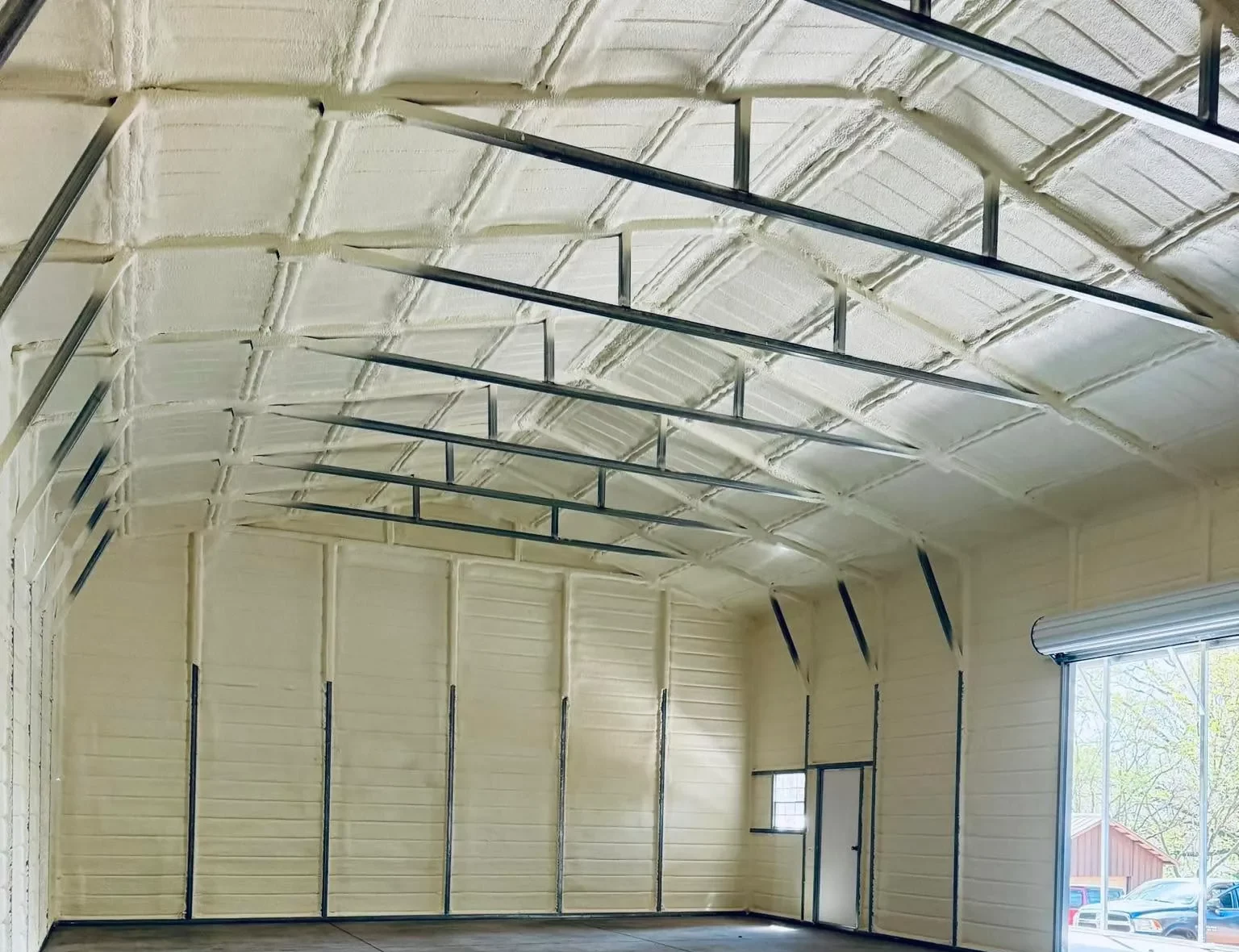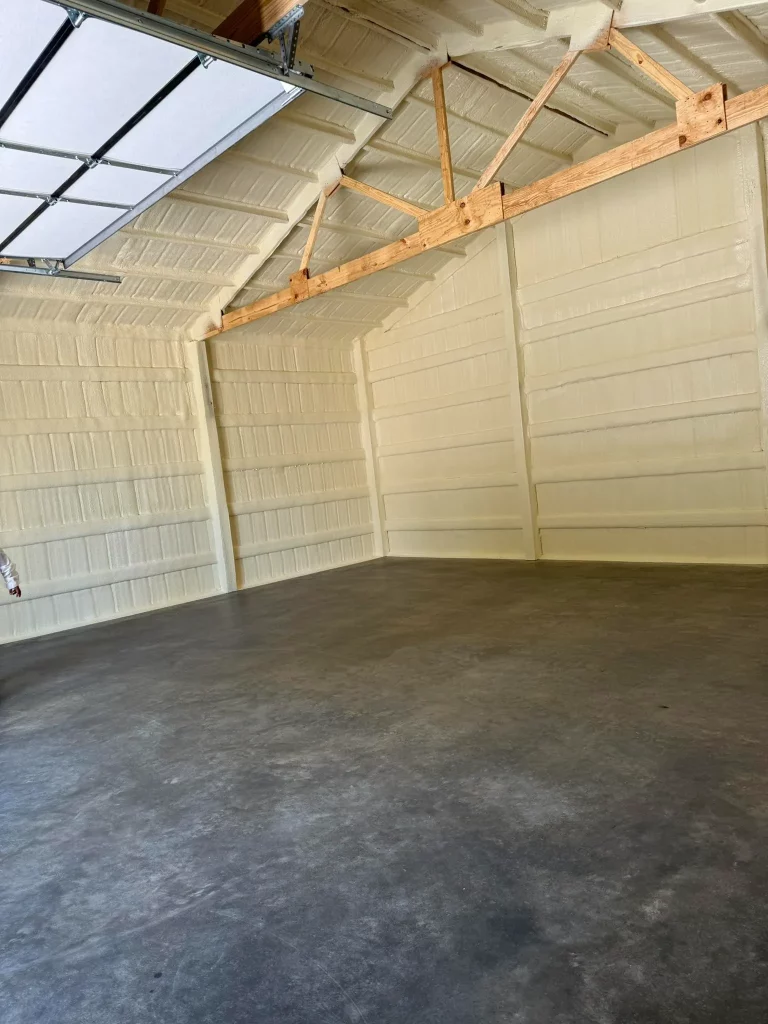
Spray foam insulation dramatically improves energy efficiency in Texarkana, Arkansas by creating an airtight thermal barrier that reduces heating and cooling costs by 30-50% compared to traditional insulation methods. The continuous seal eliminates air leakage points that account for up to 40% of energy loss in typical homes, while providing superior R-values that maintain consistent indoor temperatures year-round.
Texarkana’s humid subtropical climate with hot summers and mild winters creates unique challenges for home energy efficiency. Spray foam addresses these climate-specific issues by preventing moisture infiltration, reducing cooling loads during summer months, and maintaining thermal comfort during winter temperature swings. The investment typically pays for itself within 3-7 years through reduced utility bills, making it the most cost-effective long-term insulation solution for this region.
Drawing from extensive installation experience across Northeast Texas and Southwest Arkansas, this analysis examines the technical performance characteristics, application methods, and practical benefits that make spray foam the superior choice for optimizing energy efficiency in Texarkana’s climate conditions.
Texarkana’s climate zone 3A classification demands insulation solutions that handle both high humidity and temperature variations effectively. Traditional insulation materials like fiberglass allow air movement and moisture penetration, creating thermal bridging that reduces overall system performance.
Closed-cell spray foam expands to fill cavities completely, creating a monolithic barrier with no gaps or seams. This seamless application eliminates the convective air currents that undermine other insulation types. Open-cell spray foam provides excellent air sealing while allowing controlled moisture vapor transmission, preventing condensation issues common in humid climates.
Bonus Tip: Install spray foam during moderate temperature conditions (60-80°F) for optimal expansion and curing. High humidity doesn’t affect application quality, making it ideal for Texarkana’s climate patterns.
| Insulation Type | R-Value per Inch | Air Sealing Capability | Moisture Resistance | Longevity |
|---|---|---|---|---|
| Closed-Cell Spray Foam | 6.0-7.0 | Excellent (99% reduction) | Vapor barrier | 50+ years |
| Open-Cell Spray Foam | 3.5-4.0 | Excellent (95% reduction) | Moisture permeable | 30+ years |
| Fiberglass Batts | 3.1-3.4 | Poor (minimal sealing) | Absorbs moisture | 15-25 years |
| Blown-in Cellulose | 3.2-3.8 | Moderate (settling over time) | Retains moisture | 20-30 years |
Understanding spray foam’s technical properties helps homeowners make informed decisions about energy efficiency improvements. The material’s cellular structure creates multiple performance advantages beyond simple thermal resistance.
| Property | Closed-Cell Foam | Open-Cell Foam | Impact on Energy Efficiency |
|---|---|---|---|
| Density (lbs/ft³) | 2.0-2.2 | 0.4-0.7 | Higher density = better thermal performance |
| Compressive Strength | 35-40 psi | 3-5 psi | Structural integrity maintains R-value |
| Water Absorption | <2% | Variable | Lower absorption prevents thermal loss |
| Vapor Permeance | 0.8-1.5 perms | 16+ perms | Controls moisture-related efficiency loss |
| Operating Temperature | -100°F to 250°F | -100°F to 240°F | Maintains performance in extreme conditions |
According to the Department of Energy’s Building America program, homes with spray foam insulation show 15-20% greater energy savings compared to homes meeting standard building codes. This translates to $300-600 annual savings for typical Texarkana residences.
The Oak Ridge National Laboratory conducted field studies showing spray foam reduces air infiltration rates from 7-12 air changes per hour down to 1-3 air changes per hour, meeting ENERGY STAR performance requirements.
Professional installation technique directly impacts energy performance outcomes. Proper surface preparation, temperature control, and application depth ensure optimal thermal barrier creation.
Surface cleaning removes oils, dust, and loose materials that prevent adhesion. Temperature monitoring maintains material viscosity within manufacturer specifications. Multiple thin lifts prevent overheating and ensure complete cavity filling without voids.
Bonus Tip: Schedule installations during stable weather periods to avoid temperature fluctuations that affect curing. Morning installations often provide the most consistent conditions in Texarkana’s climate.
Critical application areas include rim joists, wall cavities, attic floors, and crawl space walls. Each location requires specific techniques to achieve maximum air sealing while maintaining proper thickness for thermal resistance.
| Building Area | Minimum R-Value | Recommended Thickness | Energy Impact |
|---|---|---|---|
| Attic Floor | R-38 to R-49 | 6-8 inches (closed-cell) | 25-35% of total savings |
| Exterior Walls | R-13 to R-19 | 2-3 inches (closed-cell) | 20-30% of total savings |
| Basement/Crawl Space | R-15 to R-25 | 2-4 inches (closed-cell) | 15-25% of total savings |
| Rim Joists | R-19 minimum | 3 inches (closed-cell) | 10-15% of total savings |
Texarkana’s specific weather patterns create distinct challenges for maintaining energy efficiency. Summer temperatures regularly exceed 90°F with high humidity levels, while winter lows can drop below freezing with significant temperature swings.
Cooling degree days average 2,800 annually, requiring consistent thermal barriers to prevent heat gain. Heating degree days total approximately 2,200, demanding insulation that maintains warmth during cold snaps. Spray foam’s continuous barrier performs effectively across this entire temperature range.
High humidity levels (often 70-80%) require moisture management strategies. Closed-cell foam acts as a vapor barrier, preventing humid air infiltration. Open-cell foam allows controlled vapor transmission while blocking air movement that carries moisture into building assemblies.
Bonus Tip: Combine spray foam with proper ventilation systems to optimize both energy efficiency and indoor air quality in Texarkana’s humid climate.
Several factors influence spray foam performance and long-term energy savings. Building age, existing insulation conditions, and specific efficiency goals affect material selection and application strategies.
Older homes often require insulation removal and air sealing preparation before spray foam application. New construction allows comprehensive thermal envelope design from the foundation up. Retrofit installations need careful evaluation of existing systems to avoid compatibility issues.
Budget considerations include upfront investment versus long-term energy savings. Closed-cell foam costs more initially but provides maximum energy efficiency gains. Open-cell foam offers moderate upfront costs with substantial efficiency improvements over traditional materials.
Professional installation ensures proper application techniques, safety protocols, and building code compliance. DIY applications rarely achieve the air sealing performance and thermal consistency that professional equipment and expertise provide.

LMC Insulation, LLC provides specialized services that maximize energy efficiency through proper spray foam application and integrated thermal barrier systems.
Spray foam insulation provides the most effective solution for maximizing energy efficiency in Texarkana’s challenging climate conditions. The complete air sealing capability combined with superior thermal resistance delivers measurable utility bill reductions while improving indoor comfort.
Professional installation ensures optimal performance through proper material selection, application techniques, and building integration. The investment provides long-term value through reduced energy costs, improved comfort, and enhanced building durability.
Evaluate current insulation conditions, energy efficiency goals, and budget parameters to select the spray foam solution that maximizes benefits for specific building requirements and climate conditions.
Typical payback periods range from 3-7 years depending on home size, existing insulation conditions, and local utility rates. Homes with minimal existing insulation see faster payback times due to greater efficiency improvements.
Spray foam maintains consistent thermal resistance year-round, reducing cooling costs during Texarkana’s hot summers and heating costs during winter months. The continuous barrier prevents both heat gain and heat loss equally effectively.
Closed-cell spray foam acts as a vapor barrier, preventing humid outdoor air from entering building assemblies. This reduces indoor humidity levels and prevents moisture-related efficiency losses while improving comfort.
Properly installed spray foam requires no ongoing maintenance and maintains full thermal performance for decades. Regular HVAC system maintenance ensures optimal energy efficiency from the complete building system.
Most residential spray foam installations complete within 1-2 days with minimal disruption to normal routines. Occupants should vacate treated areas for 24 hours after application to allow complete curing and ventilation of any residual odors.
Transform home energy performance with proven spray foam insulation solutions designed for Texarkana’s unique climate demands. LMC Insulation, LLC delivers expert installation services that maximize energy savings through comprehensive thermal envelope improvement.
Contact [email protected] or call (479) 351-6175 to schedule a detailed energy efficiency evaluation and receive customized recommendations for optimizing building performance through advanced spray foam insulation systems.
Typical payback periods range from 3-7 years depending on home size, existing insulation conditions, and local utility rates. Homes with minimal existing insulation see faster payback times due to greater efficiency improvements.
Spray foam maintains consistent thermal resistance year-round, reducing cooling costs during Texarkana’s hot summers and heating costs during winter months. The continuous barrier prevents both heat gain and heat loss equally effectively.
Closed-cell spray foam acts as a vapor barrier, preventing humid outdoor air from entering building assemblies. This reduces indoor humidity levels and prevents moisture-related efficiency losses while improving comfort.
Properly installed spray foam requires no ongoing maintenance and maintains full thermal performance for decades. Regular HVAC system maintenance ensures optimal energy efficiency from the complete building system.
Most residential spray foam installations complete within 1-2 days with minimal disruption to normal routines. Occupants should vacate treated areas for 24 hours after application to allow complete curing and ventilation of any residual odors.